Recording Business Transaction: Analysis of Income Statements and Financial Position
VerifiedAdded on 2022/12/27
|16
|2803
|24
AI Summary
This document discusses the process of recording business transactions, including writing double entry records in T-accounts and determining opening balances. It also covers the preparation of trial balance, analysis of income statements, and evaluation of financial position. Additionally, it explains the concept of drawings in small businesses and provides calculations for financial ratios. The document is relevant for students studying accounting or finance.
Contribute Materials
Your contribution can guide someone’s learning journey. Share your
documents today.
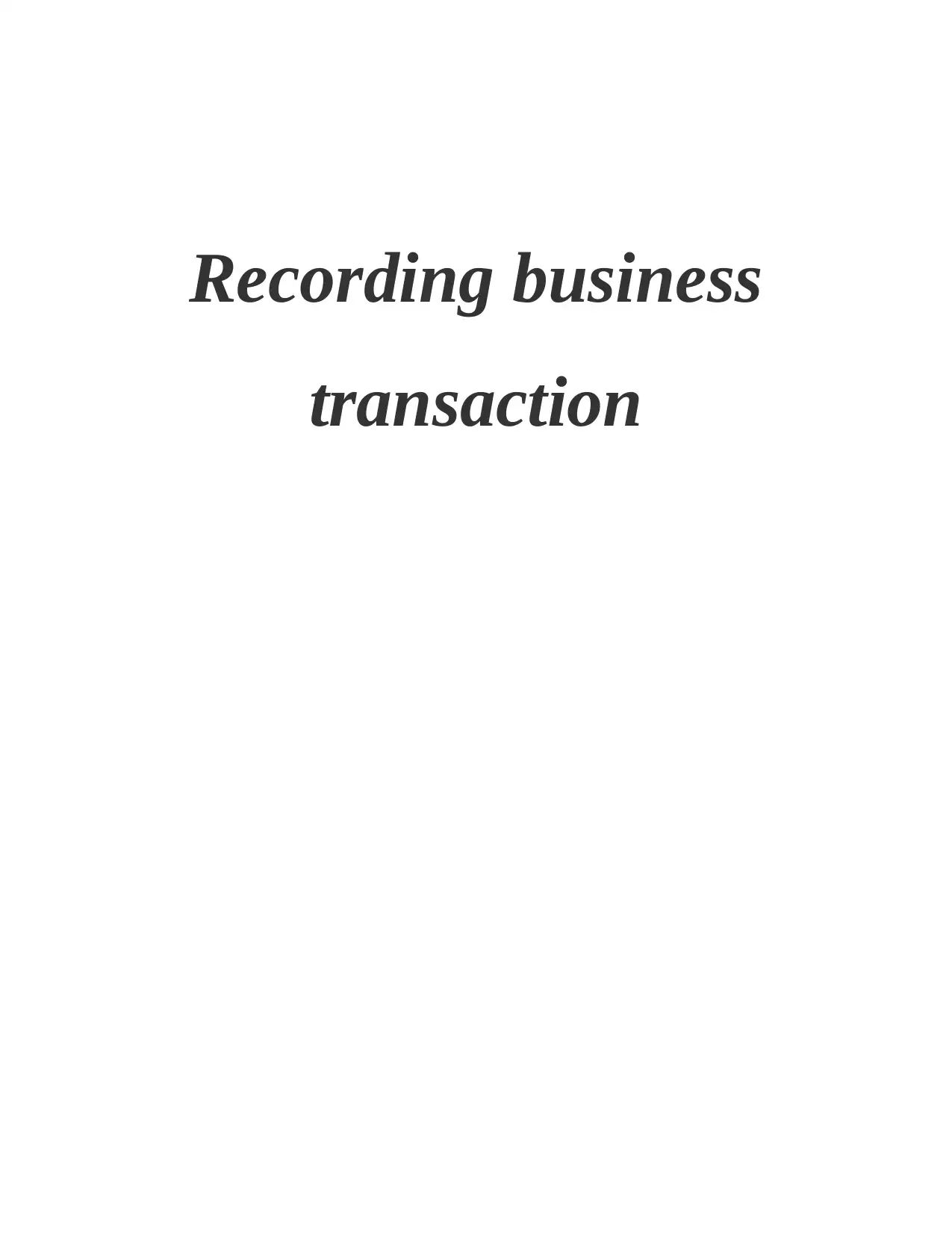
Recording business
transaction
transaction
Secure Best Marks with AI Grader
Need help grading? Try our AI Grader for instant feedback on your assignments.
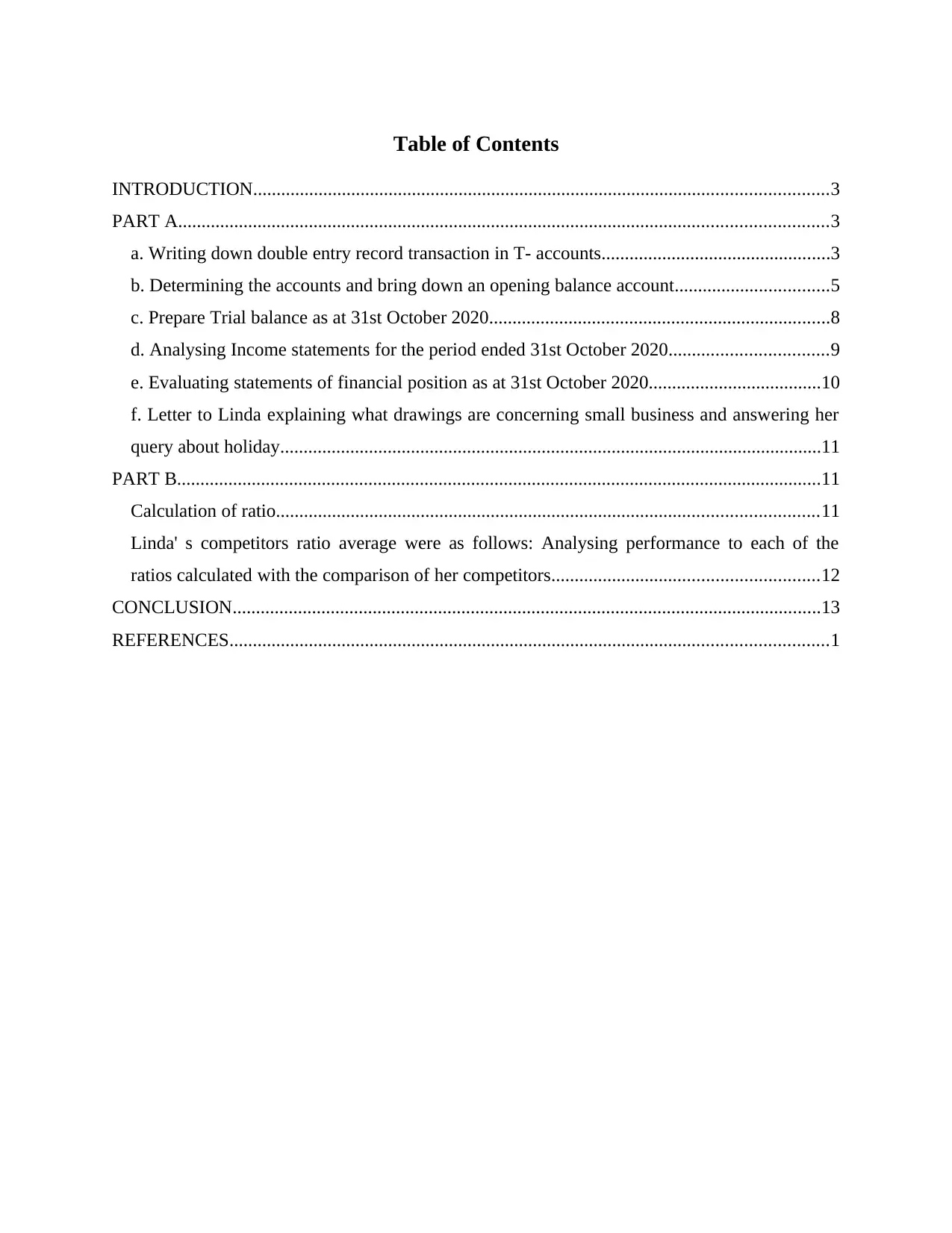
Table of Contents
INTRODUCTION...........................................................................................................................3
PART A...........................................................................................................................................3
a. Writing down double entry record transaction in T- accounts.................................................3
b. Determining the accounts and bring down an opening balance account.................................5
c. Prepare Trial balance as at 31st October 2020.........................................................................8
d. Analysing Income statements for the period ended 31st October 2020..................................9
e. Evaluating statements of financial position as at 31st October 2020.....................................10
f. Letter to Linda explaining what drawings are concerning small business and answering her
query about holiday....................................................................................................................11
PART B..........................................................................................................................................11
Calculation of ratio....................................................................................................................11
Linda' s competitors ratio average were as follows: Analysing performance to each of the
ratios calculated with the comparison of her competitors.........................................................12
CONCLUSION..............................................................................................................................13
REFERENCES................................................................................................................................1
INTRODUCTION...........................................................................................................................3
PART A...........................................................................................................................................3
a. Writing down double entry record transaction in T- accounts.................................................3
b. Determining the accounts and bring down an opening balance account.................................5
c. Prepare Trial balance as at 31st October 2020.........................................................................8
d. Analysing Income statements for the period ended 31st October 2020..................................9
e. Evaluating statements of financial position as at 31st October 2020.....................................10
f. Letter to Linda explaining what drawings are concerning small business and answering her
query about holiday....................................................................................................................11
PART B..........................................................................................................................................11
Calculation of ratio....................................................................................................................11
Linda' s competitors ratio average were as follows: Analysing performance to each of the
ratios calculated with the comparison of her competitors.........................................................12
CONCLUSION..............................................................................................................................13
REFERENCES................................................................................................................................1
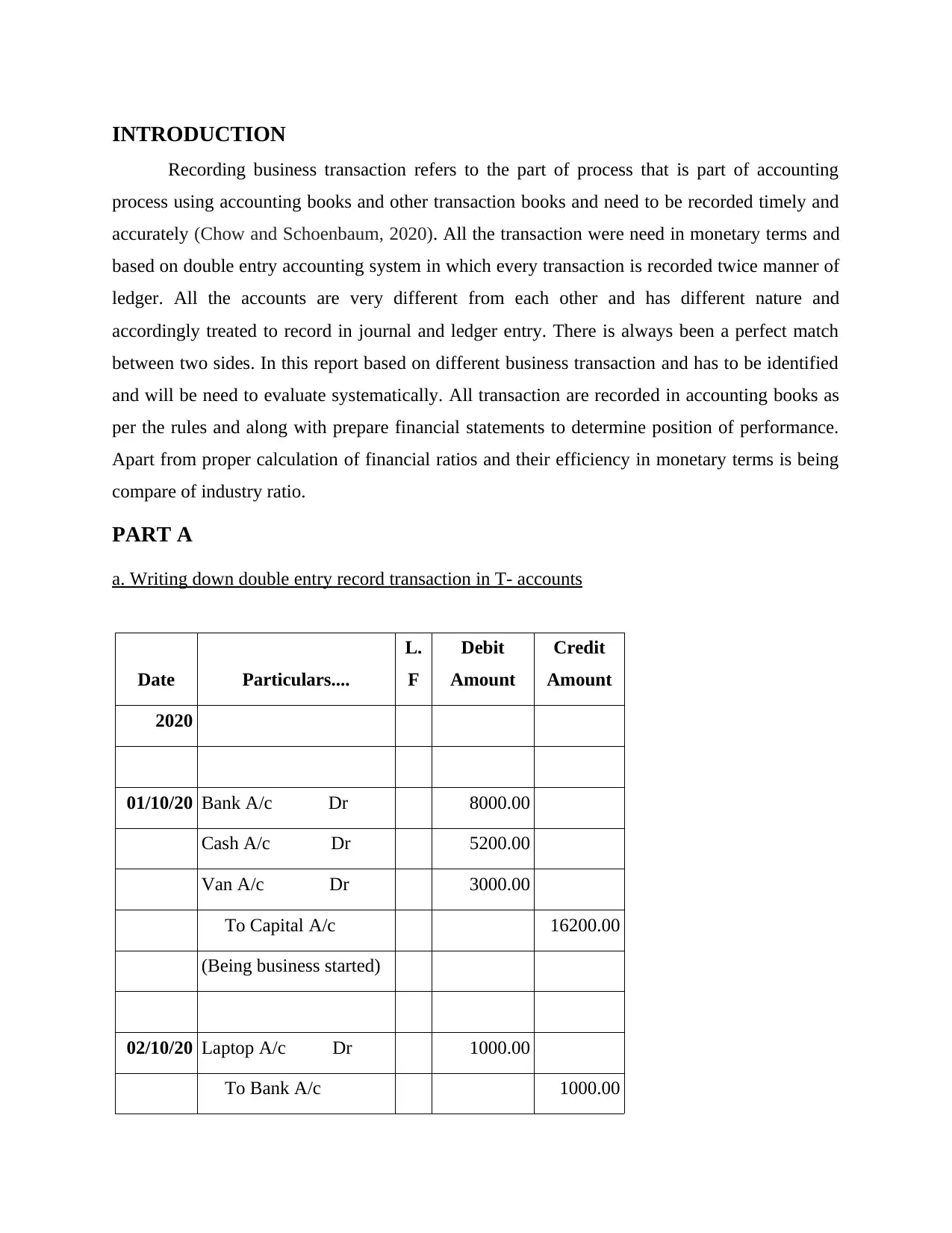
INTRODUCTION
Recording business transaction refers to the part of process that is part of accounting
process using accounting books and other transaction books and need to be recorded timely and
accurately (Chow and Schoenbaum, 2020). All the transaction were need in monetary terms and
based on double entry accounting system in which every transaction is recorded twice manner of
ledger. All the accounts are very different from each other and has different nature and
accordingly treated to record in journal and ledger entry. There is always been a perfect match
between two sides. In this report based on different business transaction and has to be identified
and will be need to evaluate systematically. All transaction are recorded in accounting books as
per the rules and along with prepare financial statements to determine position of performance.
Apart from proper calculation of financial ratios and their efficiency in monetary terms is being
compare of industry ratio.
PART A
a. Writing down double entry record transaction in T- accounts
Date Particulars....
L.
F
Debit
Amount
Credit
Amount
2020
01/10/20 Bank A/c Dr 8000.00
Cash A/c Dr 5200.00
Van A/c Dr 3000.00
To Capital A/c 16200.00
(Being business started)
02/10/20 Laptop A/c Dr 1000.00
To Bank A/c 1000.00
Recording business transaction refers to the part of process that is part of accounting
process using accounting books and other transaction books and need to be recorded timely and
accurately (Chow and Schoenbaum, 2020). All the transaction were need in monetary terms and
based on double entry accounting system in which every transaction is recorded twice manner of
ledger. All the accounts are very different from each other and has different nature and
accordingly treated to record in journal and ledger entry. There is always been a perfect match
between two sides. In this report based on different business transaction and has to be identified
and will be need to evaluate systematically. All transaction are recorded in accounting books as
per the rules and along with prepare financial statements to determine position of performance.
Apart from proper calculation of financial ratios and their efficiency in monetary terms is being
compare of industry ratio.
PART A
a. Writing down double entry record transaction in T- accounts
Date Particulars....
L.
F
Debit
Amount
Credit
Amount
2020
01/10/20 Bank A/c Dr 8000.00
Cash A/c Dr 5200.00
Van A/c Dr 3000.00
To Capital A/c 16200.00
(Being business started)
02/10/20 Laptop A/c Dr 1000.00
To Bank A/c 1000.00
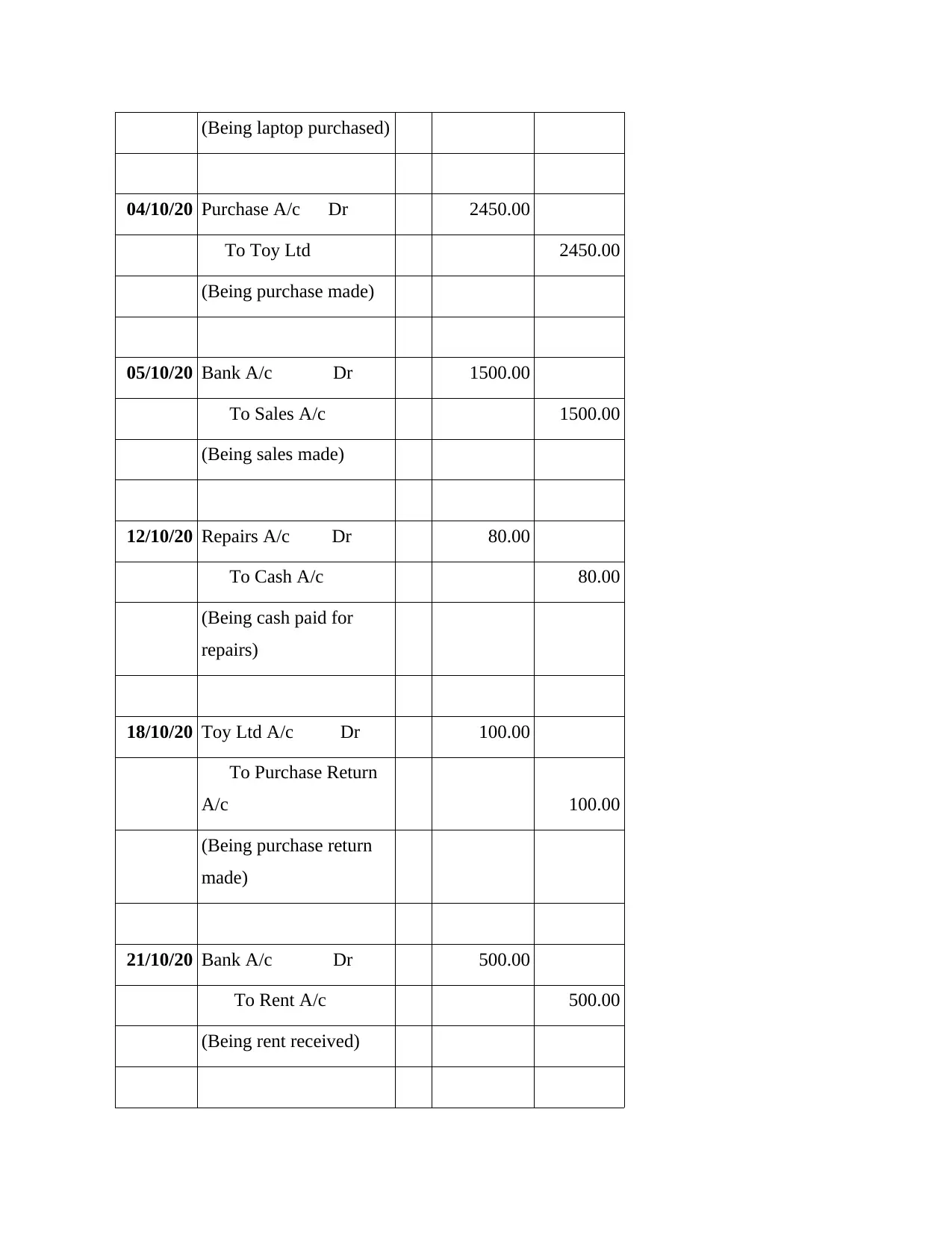
(Being laptop purchased)
04/10/20 Purchase A/c Dr 2450.00
To Toy Ltd 2450.00
(Being purchase made)
05/10/20 Bank A/c Dr 1500.00
To Sales A/c 1500.00
(Being sales made)
12/10/20 Repairs A/c Dr 80.00
To Cash A/c 80.00
(Being cash paid for
repairs)
18/10/20 Toy Ltd A/c Dr 100.00
To Purchase Return
A/c 100.00
(Being purchase return
made)
21/10/20 Bank A/c Dr 500.00
To Rent A/c 500.00
(Being rent received)
04/10/20 Purchase A/c Dr 2450.00
To Toy Ltd 2450.00
(Being purchase made)
05/10/20 Bank A/c Dr 1500.00
To Sales A/c 1500.00
(Being sales made)
12/10/20 Repairs A/c Dr 80.00
To Cash A/c 80.00
(Being cash paid for
repairs)
18/10/20 Toy Ltd A/c Dr 100.00
To Purchase Return
A/c 100.00
(Being purchase return
made)
21/10/20 Bank A/c Dr 500.00
To Rent A/c 500.00
(Being rent received)
Secure Best Marks with AI Grader
Need help grading? Try our AI Grader for instant feedback on your assignments.
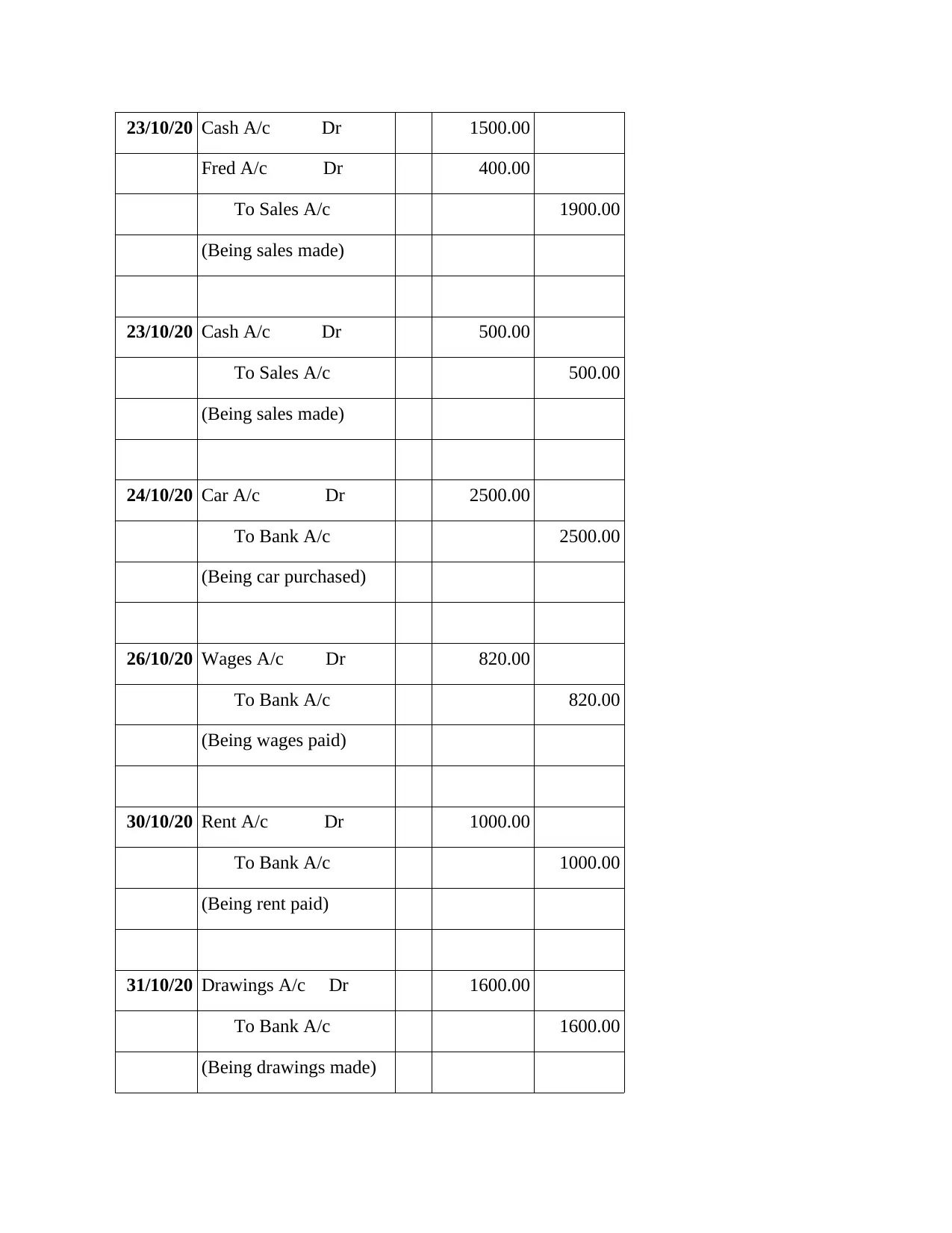
23/10/20 Cash A/c Dr 1500.00
Fred A/c Dr 400.00
To Sales A/c 1900.00
(Being sales made)
23/10/20 Cash A/c Dr 500.00
To Sales A/c 500.00
(Being sales made)
24/10/20 Car A/c Dr 2500.00
To Bank A/c 2500.00
(Being car purchased)
26/10/20 Wages A/c Dr 820.00
To Bank A/c 820.00
(Being wages paid)
30/10/20 Rent A/c Dr 1000.00
To Bank A/c 1000.00
(Being rent paid)
31/10/20 Drawings A/c Dr 1600.00
To Bank A/c 1600.00
(Being drawings made)
Fred A/c Dr 400.00
To Sales A/c 1900.00
(Being sales made)
23/10/20 Cash A/c Dr 500.00
To Sales A/c 500.00
(Being sales made)
24/10/20 Car A/c Dr 2500.00
To Bank A/c 2500.00
(Being car purchased)
26/10/20 Wages A/c Dr 820.00
To Bank A/c 820.00
(Being wages paid)
30/10/20 Rent A/c Dr 1000.00
To Bank A/c 1000.00
(Being rent paid)
31/10/20 Drawings A/c Dr 1600.00
To Bank A/c 1600.00
(Being drawings made)
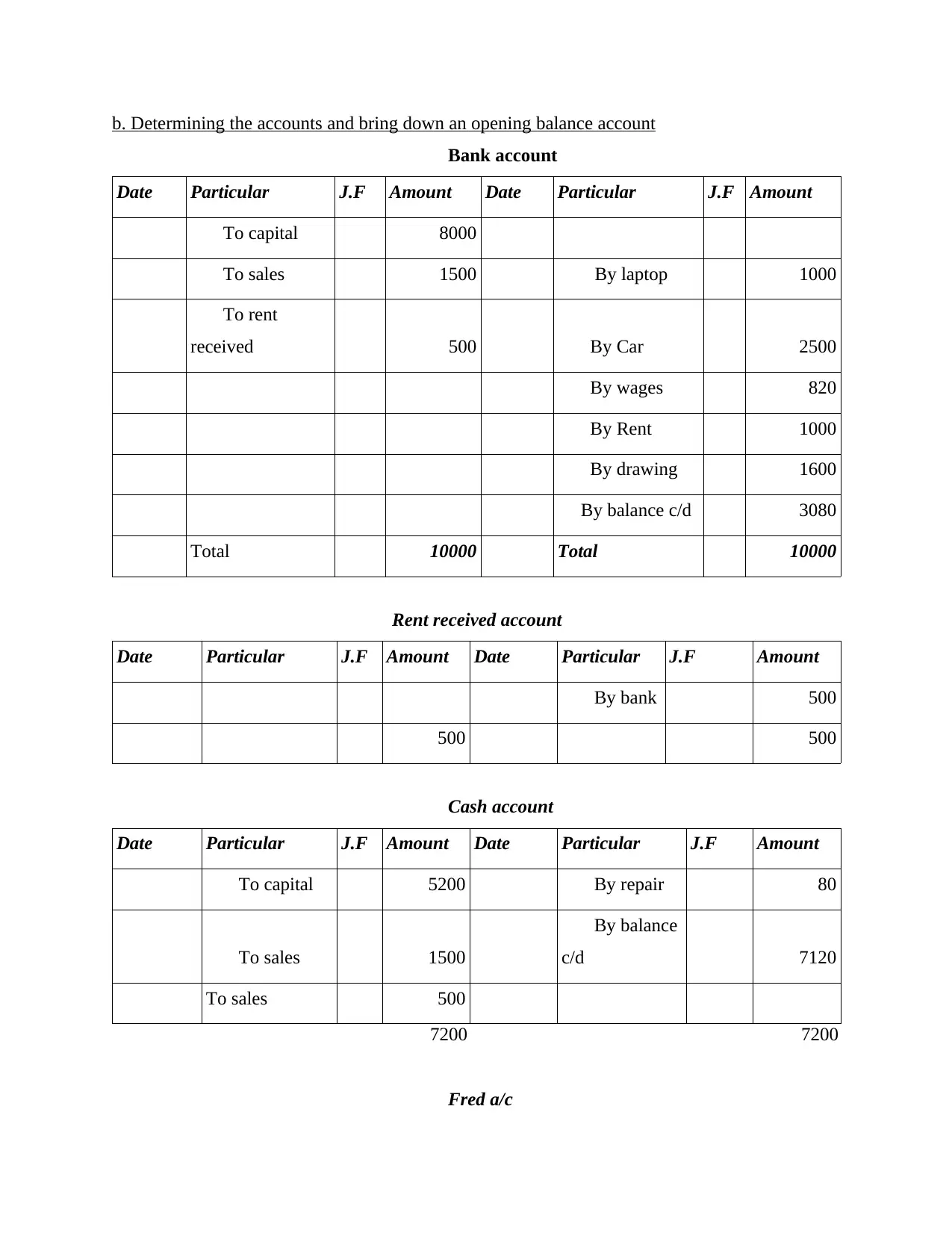
b. Determining the accounts and bring down an opening balance account
Bank account
Date Particular J.F Amount Date Particular J.F Amount
…...To capital 8000
…...To sales 1500 …....By laptop 1000
…...To rent
received 500 …...By Car 2500
…...By wages 820
…...By Rent 1000
…...By drawing 1600
….By balance c/d 3080
Total 10000 Total 10000
Rent received account
Date Particular J.F Amount Date Particular J.F Amount
…...By bank 500
500 500
Cash account
Date Particular J.F Amount Date Particular J.F Amount
…...To capital 5200 …...By repair 80
…...To sales 1500
…...By balance
c/d 7120
To sales 500
7200 7200
Fred a/c
Bank account
Date Particular J.F Amount Date Particular J.F Amount
…...To capital 8000
…...To sales 1500 …....By laptop 1000
…...To rent
received 500 …...By Car 2500
…...By wages 820
…...By Rent 1000
…...By drawing 1600
….By balance c/d 3080
Total 10000 Total 10000
Rent received account
Date Particular J.F Amount Date Particular J.F Amount
…...By bank 500
500 500
Cash account
Date Particular J.F Amount Date Particular J.F Amount
…...To capital 5200 …...By repair 80
…...To sales 1500
…...By balance
c/d 7120
To sales 500
7200 7200
Fred a/c

Date Particular J.F Amount Date Particular J.F Amount
…...To sales 400
…...By balance
b/d 400
Purchase a/c
Date Particular J.F Amount Date Particular J.F Amount
…...To Toys
limited 2450
…...By balance
c/d 2450
Toys limited a/c
Date Particular J.F Amount Date Particular J.F Amount
…...To purchase
return 100
…...By
purchase 2450
…...To balance
b/d 2350
2450 2450
Rent a/c
Date Particular J.F Amount Date Particular J.F Amount
…...To Bank 1000
…...By
balance b/d 1000
Van a/c
Date Particular J.F Amount Date Particular J.F Amount
…...To
capital 3000
…...By
balance b/d 3000
…...To sales 400
…...By balance
b/d 400
Purchase a/c
Date Particular J.F Amount Date Particular J.F Amount
…...To Toys
limited 2450
…...By balance
c/d 2450
Toys limited a/c
Date Particular J.F Amount Date Particular J.F Amount
…...To purchase
return 100
…...By
purchase 2450
…...To balance
b/d 2350
2450 2450
Rent a/c
Date Particular J.F Amount Date Particular J.F Amount
…...To Bank 1000
…...By
balance b/d 1000
Van a/c
Date Particular J.F Amount Date Particular J.F Amount
…...To
capital 3000
…...By
balance b/d 3000
Paraphrase This Document
Need a fresh take? Get an instant paraphrase of this document with our AI Paraphraser
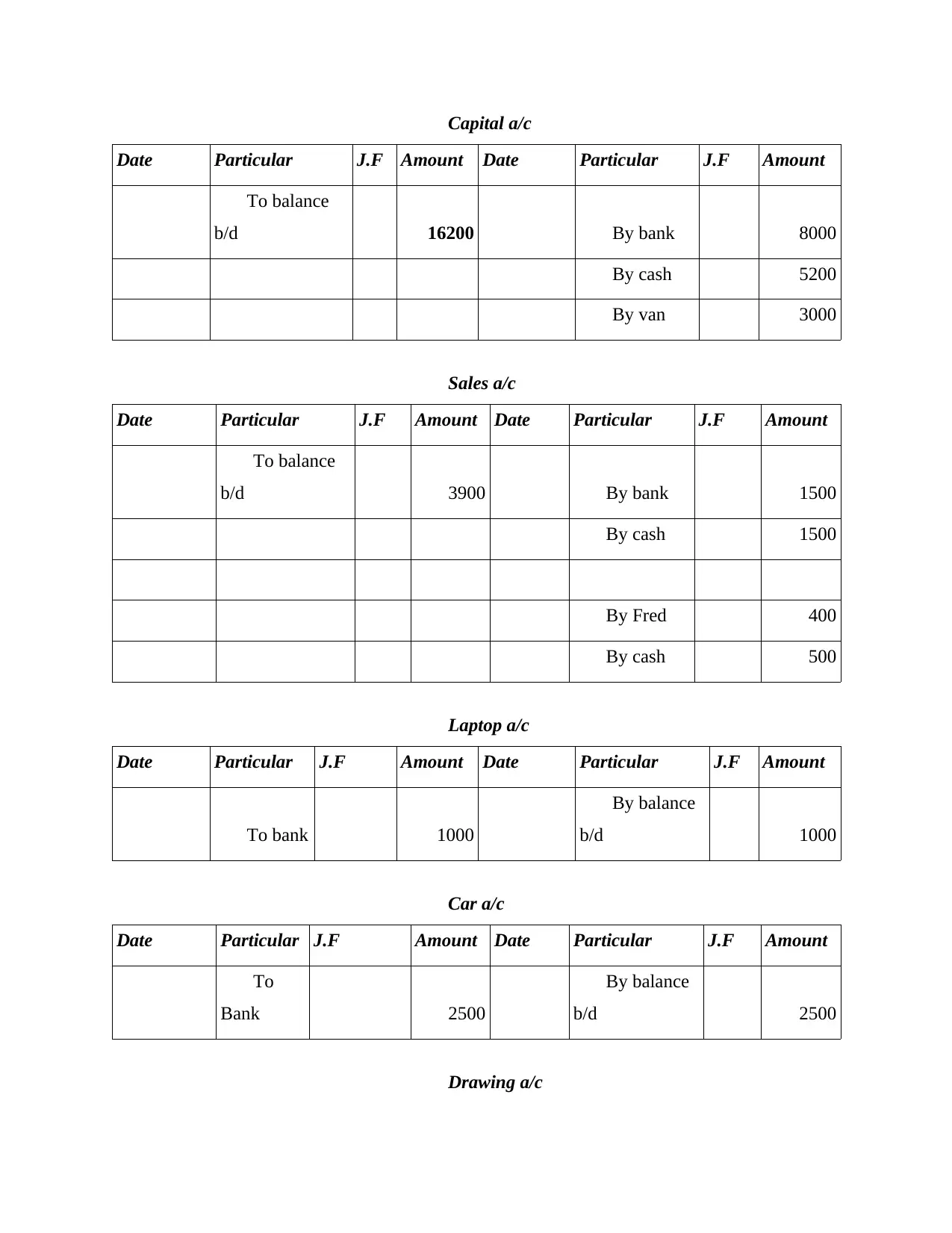
Capital a/c
Date Particular J.F Amount Date Particular J.F Amount
…...To balance
b/d 16200 …...By bank 8000
…...By cash 5200
…...By van 3000
Sales a/c
Date Particular J.F Amount Date Particular J.F Amount
…...To balance
b/d 3900 …...By bank 1500
…...By cash 1500
…...By Fred 400
…...By cash 500
Laptop a/c
Date Particular J.F Amount Date Particular J.F Amount
…...To bank 1000
…...By balance
b/d 1000
Car a/c
Date Particular J.F Amount Date Particular J.F Amount
…...To
Bank 2500
…...By balance
b/d 2500
Drawing a/c
Date Particular J.F Amount Date Particular J.F Amount
…...To balance
b/d 16200 …...By bank 8000
…...By cash 5200
…...By van 3000
Sales a/c
Date Particular J.F Amount Date Particular J.F Amount
…...To balance
b/d 3900 …...By bank 1500
…...By cash 1500
…...By Fred 400
…...By cash 500
Laptop a/c
Date Particular J.F Amount Date Particular J.F Amount
…...To bank 1000
…...By balance
b/d 1000
Car a/c
Date Particular J.F Amount Date Particular J.F Amount
…...To
Bank 2500
…...By balance
b/d 2500
Drawing a/c
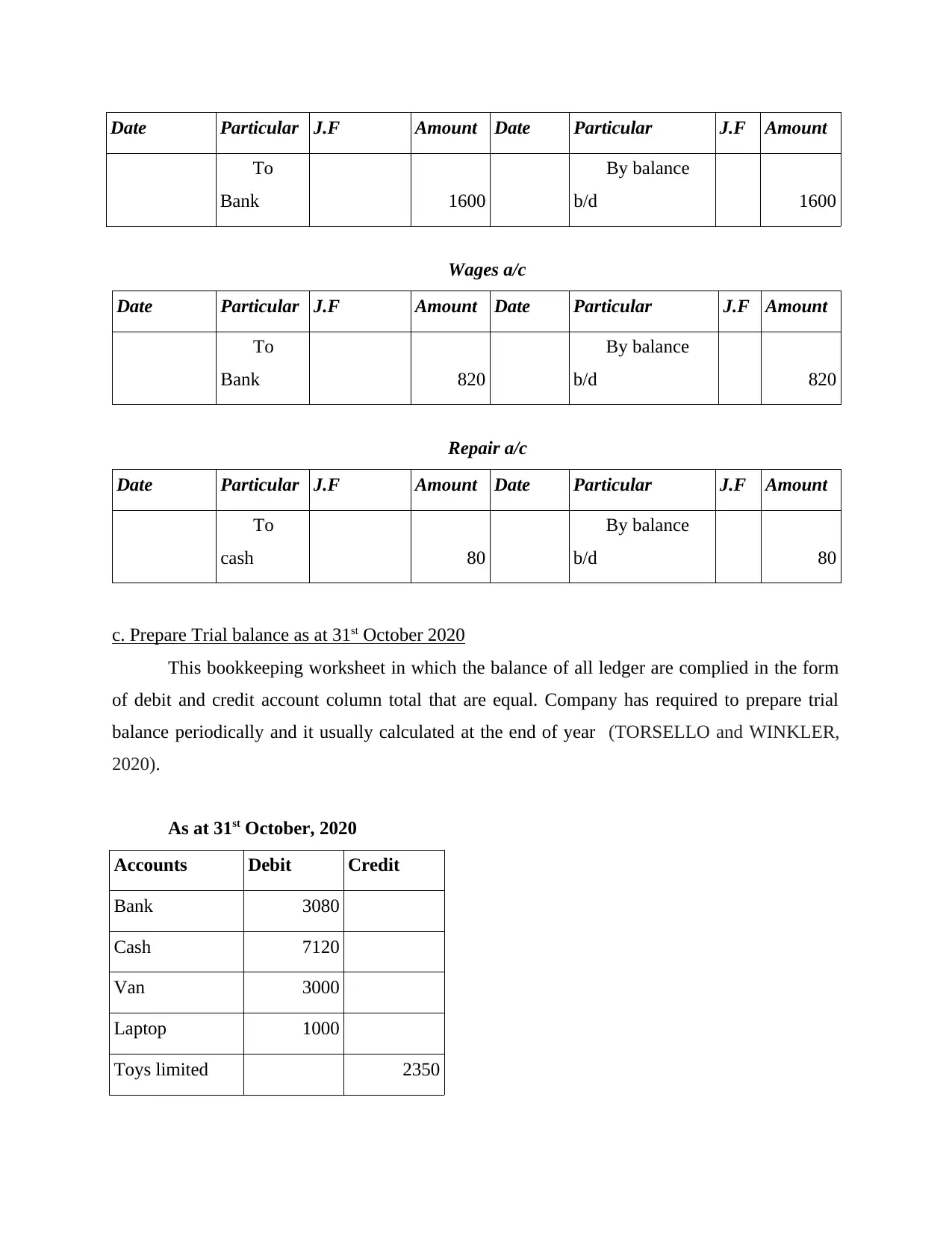
Date Particular J.F Amount Date Particular J.F Amount
…...To
Bank 1600
…...By balance
b/d 1600
Wages a/c
Date Particular J.F Amount Date Particular J.F Amount
…...To
Bank 820
…...By balance
b/d 820
Repair a/c
Date Particular J.F Amount Date Particular J.F Amount
…...To
cash 80
…...By balance
b/d 80
c. Prepare Trial balance as at 31st October 2020
This bookkeeping worksheet in which the balance of all ledger are complied in the form
of debit and credit account column total that are equal. Company has required to prepare trial
balance periodically and it usually calculated at the end of year (TORSELLO and WINKLER,
2020).
As at 31st October, 2020
Accounts Debit Credit
Bank 3080
Cash 7120
Van 3000
Laptop 1000
Toys limited 2350
…...To
Bank 1600
…...By balance
b/d 1600
Wages a/c
Date Particular J.F Amount Date Particular J.F Amount
…...To
Bank 820
…...By balance
b/d 820
Repair a/c
Date Particular J.F Amount Date Particular J.F Amount
…...To
cash 80
…...By balance
b/d 80
c. Prepare Trial balance as at 31st October 2020
This bookkeeping worksheet in which the balance of all ledger are complied in the form
of debit and credit account column total that are equal. Company has required to prepare trial
balance periodically and it usually calculated at the end of year (TORSELLO and WINKLER,
2020).
As at 31st October, 2020
Accounts Debit Credit
Bank 3080
Cash 7120
Van 3000
Laptop 1000
Toys limited 2350
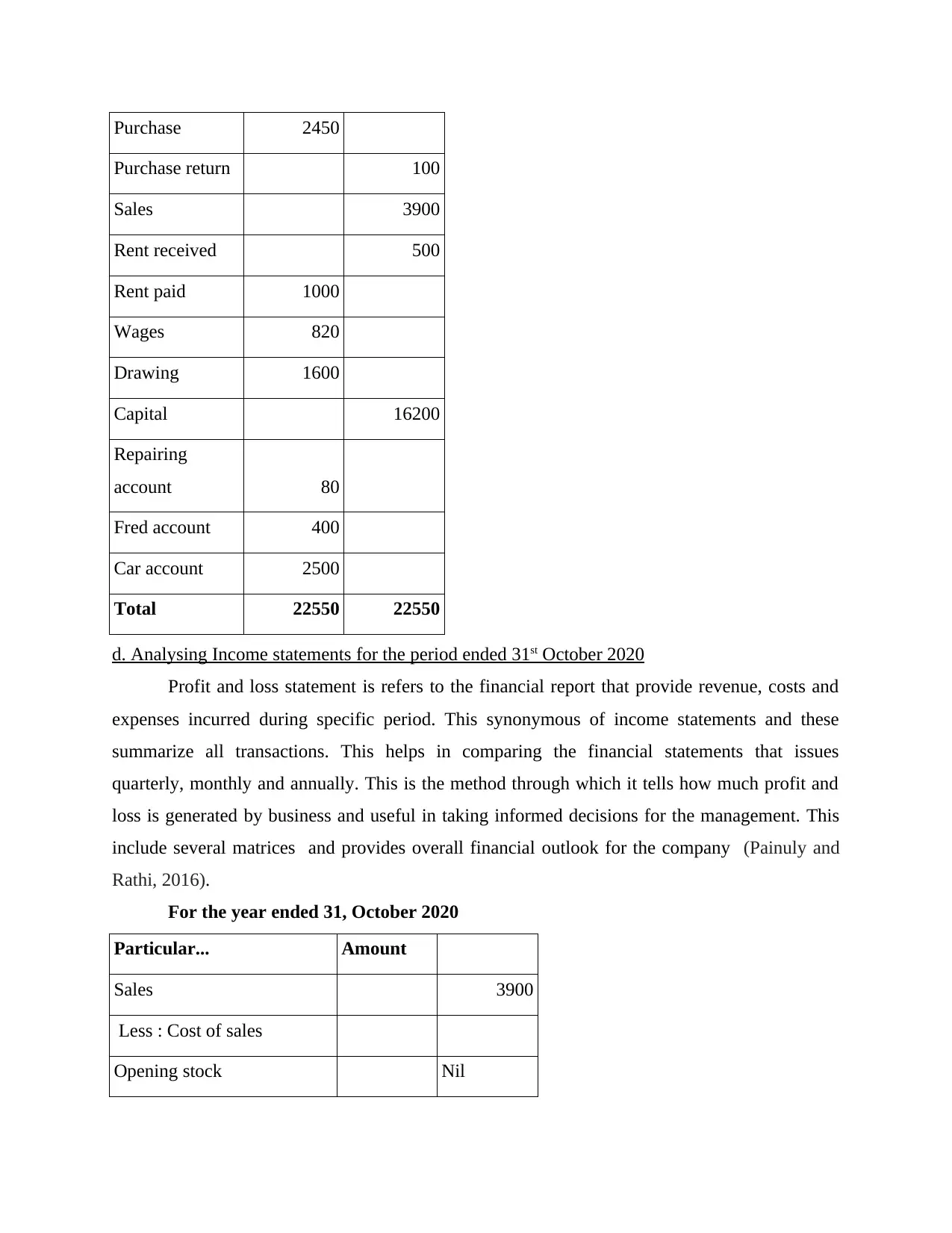
Purchase 2450
Purchase return 100
Sales 3900
Rent received 500
Rent paid 1000
Wages 820
Drawing 1600
Capital 16200
Repairing
account 80
Fred account 400
Car account 2500
Total 22550 22550
d. Analysing Income statements for the period ended 31st October 2020
Profit and loss statement is refers to the financial report that provide revenue, costs and
expenses incurred during specific period. This synonymous of income statements and these
summarize all transactions. This helps in comparing the financial statements that issues
quarterly, monthly and annually. This is the method through which it tells how much profit and
loss is generated by business and useful in taking informed decisions for the management. This
include several matrices and provides overall financial outlook for the company (Painuly and
Rathi, 2016).
For the year ended 31, October 2020
Particular... Amount
Sales 3900
Less : Cost of sales
Opening stock Nil
Purchase return 100
Sales 3900
Rent received 500
Rent paid 1000
Wages 820
Drawing 1600
Capital 16200
Repairing
account 80
Fred account 400
Car account 2500
Total 22550 22550
d. Analysing Income statements for the period ended 31st October 2020
Profit and loss statement is refers to the financial report that provide revenue, costs and
expenses incurred during specific period. This synonymous of income statements and these
summarize all transactions. This helps in comparing the financial statements that issues
quarterly, monthly and annually. This is the method through which it tells how much profit and
loss is generated by business and useful in taking informed decisions for the management. This
include several matrices and provides overall financial outlook for the company (Painuly and
Rathi, 2016).
For the year ended 31, October 2020
Particular... Amount
Sales 3900
Less : Cost of sales
Opening stock Nil
Secure Best Marks with AI Grader
Need help grading? Try our AI Grader for instant feedback on your assignments.
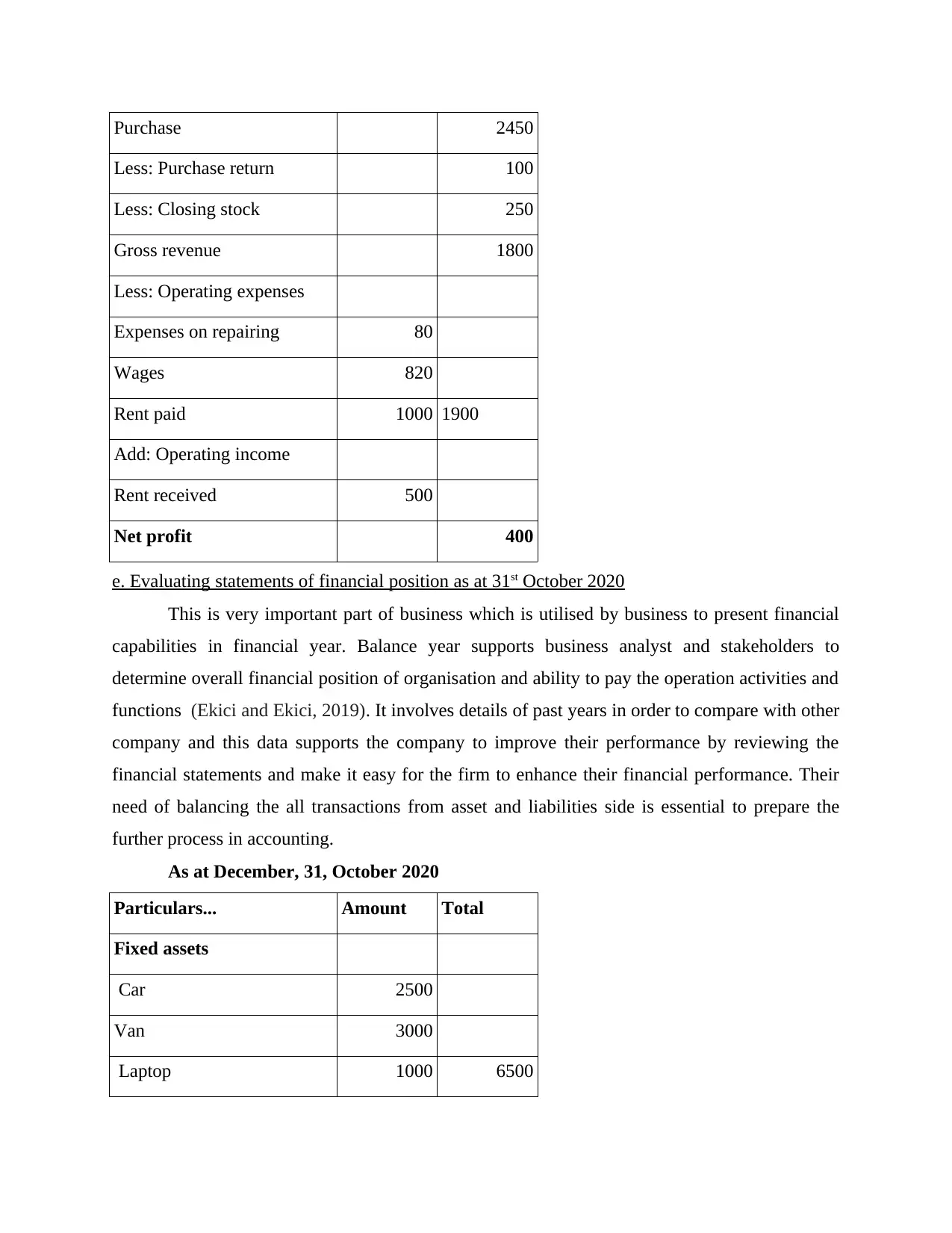
Purchase 2450
Less: Purchase return 100
Less: Closing stock 250
Gross revenue 1800
Less: Operating expenses
Expenses on repairing 80
Wages 820
Rent paid 1000 1900
Add: Operating income
Rent received 500
Net profit 400
e. Evaluating statements of financial position as at 31st October 2020
This is very important part of business which is utilised by business to present financial
capabilities in financial year. Balance year supports business analyst and stakeholders to
determine overall financial position of organisation and ability to pay the operation activities and
functions (Ekici and Ekici, 2019). It involves details of past years in order to compare with other
company and this data supports the company to improve their performance by reviewing the
financial statements and make it easy for the firm to enhance their financial performance. Their
need of balancing the all transactions from asset and liabilities side is essential to prepare the
further process in accounting.
As at December, 31, October 2020
Particulars... Amount Total
Fixed assets
.Car 2500
Van 3000
.Laptop 1000 6500
Less: Purchase return 100
Less: Closing stock 250
Gross revenue 1800
Less: Operating expenses
Expenses on repairing 80
Wages 820
Rent paid 1000 1900
Add: Operating income
Rent received 500
Net profit 400
e. Evaluating statements of financial position as at 31st October 2020
This is very important part of business which is utilised by business to present financial
capabilities in financial year. Balance year supports business analyst and stakeholders to
determine overall financial position of organisation and ability to pay the operation activities and
functions (Ekici and Ekici, 2019). It involves details of past years in order to compare with other
company and this data supports the company to improve their performance by reviewing the
financial statements and make it easy for the firm to enhance their financial performance. Their
need of balancing the all transactions from asset and liabilities side is essential to prepare the
further process in accounting.
As at December, 31, October 2020
Particulars... Amount Total
Fixed assets
.Car 2500
Van 3000
.Laptop 1000 6500

Current Assets
.Cash account 7120
.Bank account 3080
Debtor 400
Stock 250
Total assets 17350
Equity and liabilities
..Equity
..Capital 16200
.Less : Drawing 1600 14600
..Retain earnings 400
Current liabilities
..Toys limited account 2350
Total equities and
liabilities 17350
f. Letter to Linda explaining what drawings are concerning small business and answering her
query about holiday
Drawings act of withdrawal of money from business entity for personal use and shows in
business account and if amount used by the owner for personal work so it is important for the
owner to pay off at the end of financial year (Cuniberti, 2016). In this year the sole proprietor
and business entity has totally different identity. In small businesses, the amount of drawings
deduct the capital of owner's equity of organisation and it is essential to keep the recording of
drawings and arrange them in accounts properly. Linda withdraw amount from the organisation
for travelling and if it is used for personal use and it returned in specific period of time. If it has
used for business purpose and activities conduct for the business than it will be consider as
.Cash account 7120
.Bank account 3080
Debtor 400
Stock 250
Total assets 17350
Equity and liabilities
..Equity
..Capital 16200
.Less : Drawing 1600 14600
..Retain earnings 400
Current liabilities
..Toys limited account 2350
Total equities and
liabilities 17350
f. Letter to Linda explaining what drawings are concerning small business and answering her
query about holiday
Drawings act of withdrawal of money from business entity for personal use and shows in
business account and if amount used by the owner for personal work so it is important for the
owner to pay off at the end of financial year (Cuniberti, 2016). In this year the sole proprietor
and business entity has totally different identity. In small businesses, the amount of drawings
deduct the capital of owner's equity of organisation and it is essential to keep the recording of
drawings and arrange them in accounts properly. Linda withdraw amount from the organisation
for travelling and if it is used for personal use and it returned in specific period of time. If it has
used for business purpose and activities conduct for the business than it will be consider as
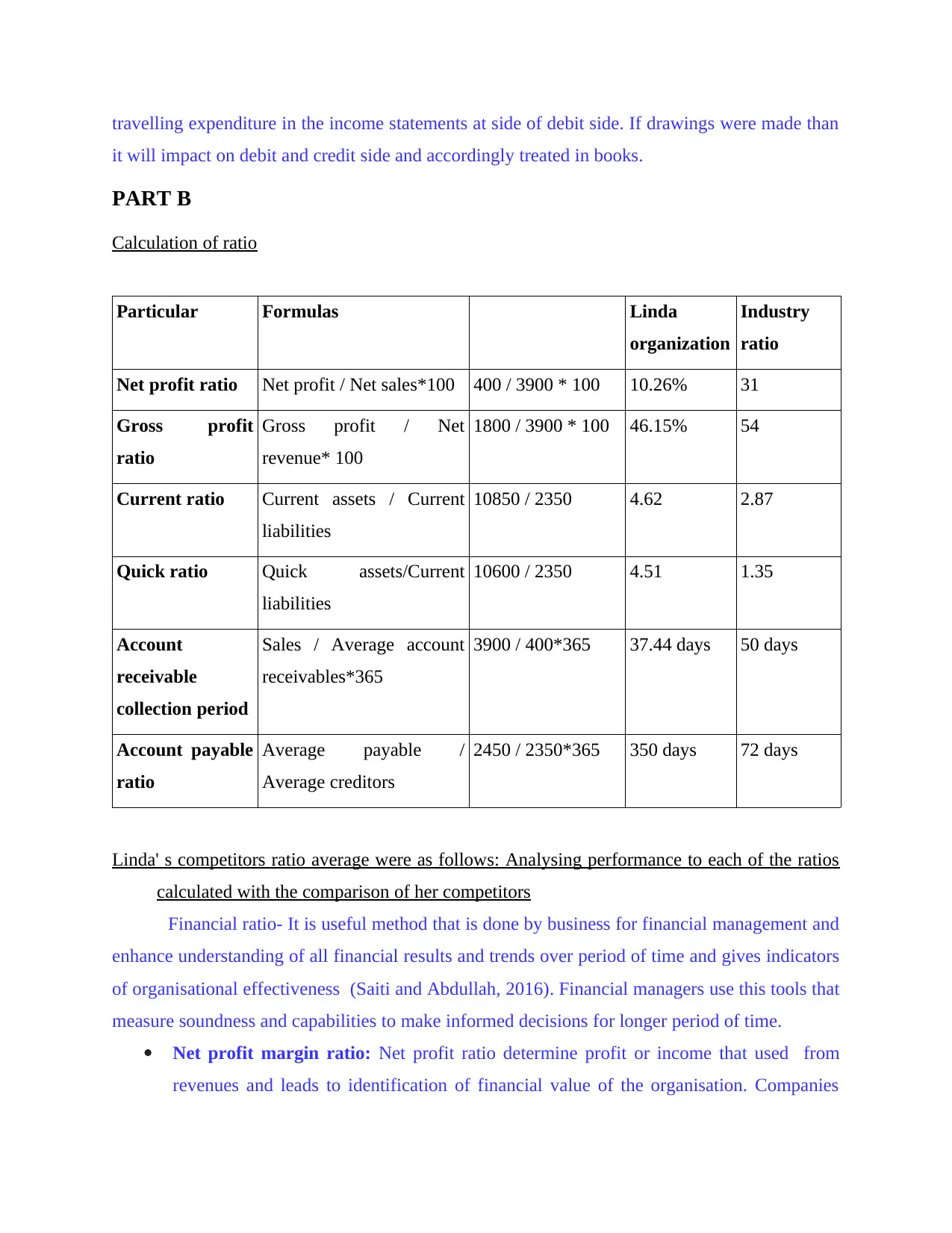
travelling expenditure in the income statements at side of debit side. If drawings were made than
it will impact on debit and credit side and accordingly treated in books.
PART B
Calculation of ratio
Particular Formulas Linda
organization
Industry
ratio
Net profit ratio Net profit / Net sales*100 400 / 3900 * 100 10.26% 31
Gross profit
ratio
Gross profit / Net
revenue* 100
1800 / 3900 * 100 46.15% 54
Current ratio Current assets / Current
liabilities
10850 / 2350 4.62 2.87
Quick ratio Quick assets/Current
liabilities
10600 / 2350 4.51 1.35
Account
receivable
collection period
Sales / Average account
receivables*365
3900 / 400*365 37.44 days 50 days
Account payable
ratio
Average payable /
Average creditors
2450 / 2350*365 350 days 72 days
Linda' s competitors ratio average were as follows: Analysing performance to each of the ratios
calculated with the comparison of her competitors
Financial ratio- It is useful method that is done by business for financial management and
enhance understanding of all financial results and trends over period of time and gives indicators
of organisational effectiveness (Saiti and Abdullah, 2016). Financial managers use this tools that
measure soundness and capabilities to make informed decisions for longer period of time.
Net profit margin ratio: Net profit ratio determine profit or income that used from
revenues and leads to identification of financial value of the organisation. Companies
it will impact on debit and credit side and accordingly treated in books.
PART B
Calculation of ratio
Particular Formulas Linda
organization
Industry
ratio
Net profit ratio Net profit / Net sales*100 400 / 3900 * 100 10.26% 31
Gross profit
ratio
Gross profit / Net
revenue* 100
1800 / 3900 * 100 46.15% 54
Current ratio Current assets / Current
liabilities
10850 / 2350 4.62 2.87
Quick ratio Quick assets/Current
liabilities
10600 / 2350 4.51 1.35
Account
receivable
collection period
Sales / Average account
receivables*365
3900 / 400*365 37.44 days 50 days
Account payable
ratio
Average payable /
Average creditors
2450 / 2350*365 350 days 72 days
Linda' s competitors ratio average were as follows: Analysing performance to each of the ratios
calculated with the comparison of her competitors
Financial ratio- It is useful method that is done by business for financial management and
enhance understanding of all financial results and trends over period of time and gives indicators
of organisational effectiveness (Saiti and Abdullah, 2016). Financial managers use this tools that
measure soundness and capabilities to make informed decisions for longer period of time.
Net profit margin ratio: Net profit ratio determine profit or income that used from
revenues and leads to identification of financial value of the organisation. Companies
Paraphrase This Document
Need a fresh take? Get an instant paraphrase of this document with our AI Paraphraser
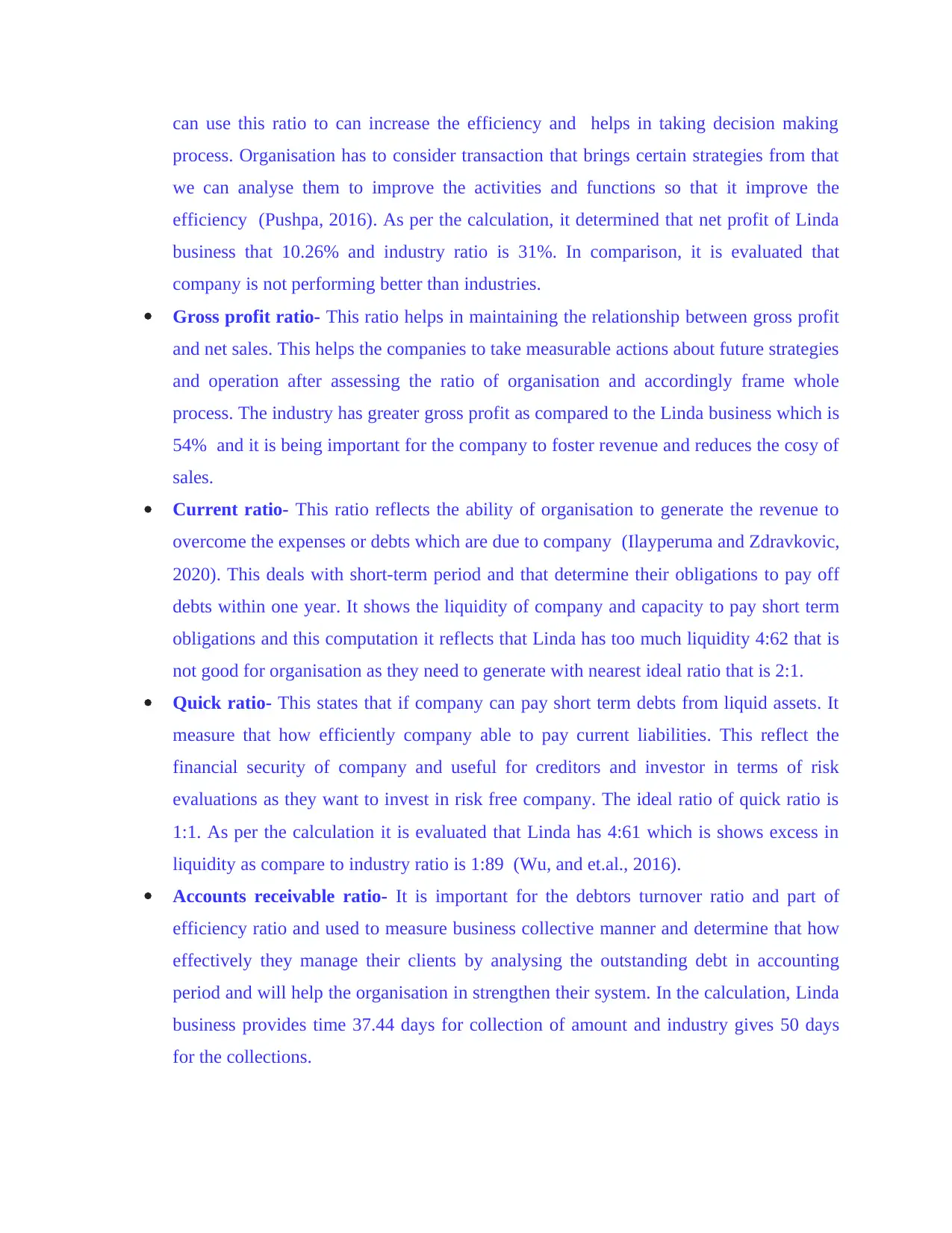
can use this ratio to can increase the efficiency and helps in taking decision making
process. Organisation has to consider transaction that brings certain strategies from that
we can analyse them to improve the activities and functions so that it improve the
efficiency (Pushpa, 2016). As per the calculation, it determined that net profit of Linda
business that 10.26% and industry ratio is 31%. In comparison, it is evaluated that
company is not performing better than industries.
Gross profit ratio- This ratio helps in maintaining the relationship between gross profit
and net sales. This helps the companies to take measurable actions about future strategies
and operation after assessing the ratio of organisation and accordingly frame whole
process. The industry has greater gross profit as compared to the Linda business which is
54% and it is being important for the company to foster revenue and reduces the cosy of
sales.
Current ratio- This ratio reflects the ability of organisation to generate the revenue to
overcome the expenses or debts which are due to company (Ilayperuma and Zdravkovic,
2020). This deals with short-term period and that determine their obligations to pay off
debts within one year. It shows the liquidity of company and capacity to pay short term
obligations and this computation it reflects that Linda has too much liquidity 4:62 that is
not good for organisation as they need to generate with nearest ideal ratio that is 2:1.
Quick ratio- This states that if company can pay short term debts from liquid assets. It
measure that how efficiently company able to pay current liabilities. This reflect the
financial security of company and useful for creditors and investor in terms of risk
evaluations as they want to invest in risk free company. The ideal ratio of quick ratio is
1:1. As per the calculation it is evaluated that Linda has 4:61 which is shows excess in
liquidity as compare to industry ratio is 1:89 (Wu, and et.al., 2016).
Accounts receivable ratio- It is important for the debtors turnover ratio and part of
efficiency ratio and used to measure business collective manner and determine that how
effectively they manage their clients by analysing the outstanding debt in accounting
period and will help the organisation in strengthen their system. In the calculation, Linda
business provides time 37.44 days for collection of amount and industry gives 50 days
for the collections.
process. Organisation has to consider transaction that brings certain strategies from that
we can analyse them to improve the activities and functions so that it improve the
efficiency (Pushpa, 2016). As per the calculation, it determined that net profit of Linda
business that 10.26% and industry ratio is 31%. In comparison, it is evaluated that
company is not performing better than industries.
Gross profit ratio- This ratio helps in maintaining the relationship between gross profit
and net sales. This helps the companies to take measurable actions about future strategies
and operation after assessing the ratio of organisation and accordingly frame whole
process. The industry has greater gross profit as compared to the Linda business which is
54% and it is being important for the company to foster revenue and reduces the cosy of
sales.
Current ratio- This ratio reflects the ability of organisation to generate the revenue to
overcome the expenses or debts which are due to company (Ilayperuma and Zdravkovic,
2020). This deals with short-term period and that determine their obligations to pay off
debts within one year. It shows the liquidity of company and capacity to pay short term
obligations and this computation it reflects that Linda has too much liquidity 4:62 that is
not good for organisation as they need to generate with nearest ideal ratio that is 2:1.
Quick ratio- This states that if company can pay short term debts from liquid assets. It
measure that how efficiently company able to pay current liabilities. This reflect the
financial security of company and useful for creditors and investor in terms of risk
evaluations as they want to invest in risk free company. The ideal ratio of quick ratio is
1:1. As per the calculation it is evaluated that Linda has 4:61 which is shows excess in
liquidity as compare to industry ratio is 1:89 (Wu, and et.al., 2016).
Accounts receivable ratio- It is important for the debtors turnover ratio and part of
efficiency ratio and used to measure business collective manner and determine that how
effectively they manage their clients by analysing the outstanding debt in accounting
period and will help the organisation in strengthen their system. In the calculation, Linda
business provides time 37.44 days for collection of amount and industry gives 50 days
for the collections.
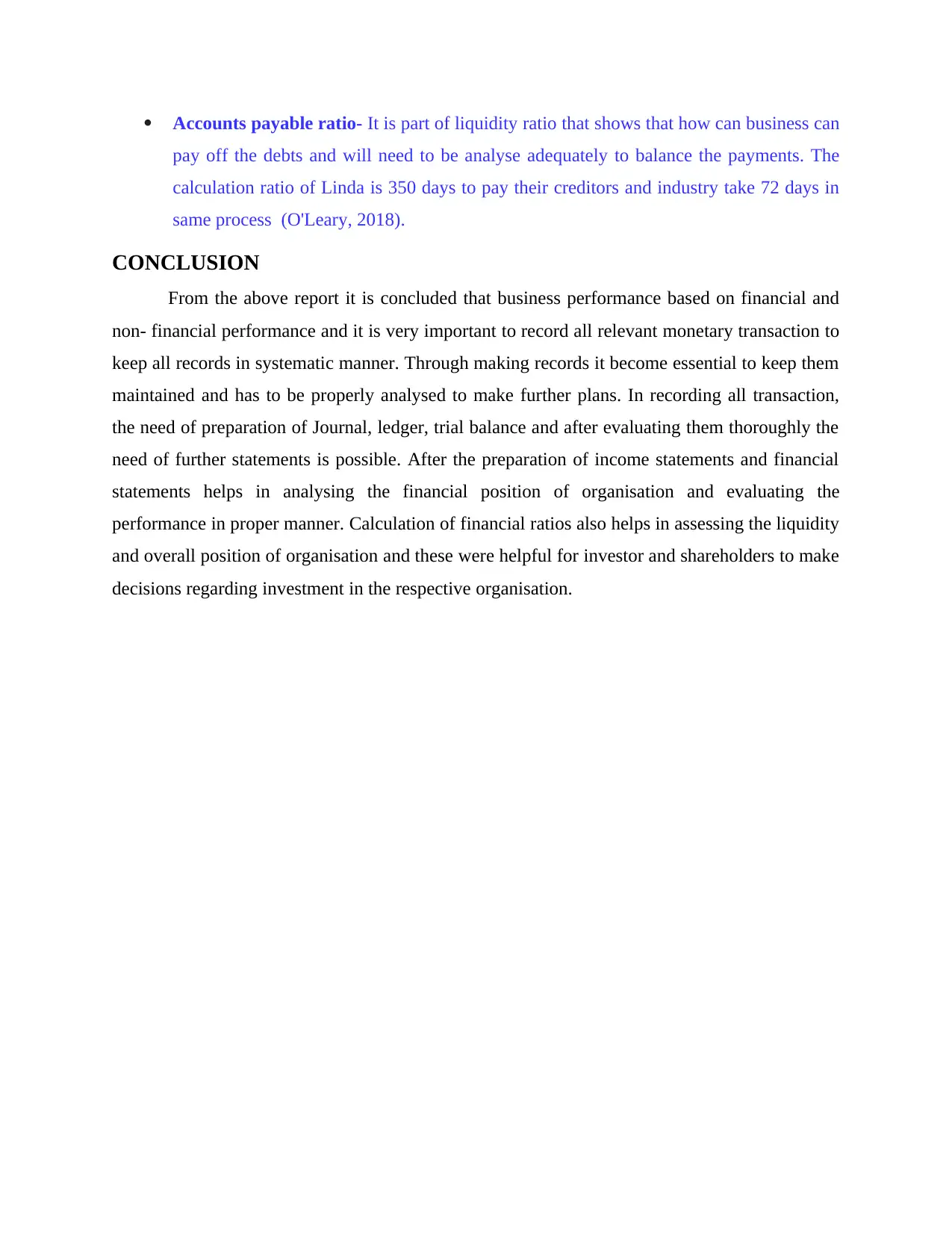
Accounts payable ratio- It is part of liquidity ratio that shows that how can business can
pay off the debts and will need to be analyse adequately to balance the payments. The
calculation ratio of Linda is 350 days to pay their creditors and industry take 72 days in
same process (O'Leary, 2018).
CONCLUSION
From the above report it is concluded that business performance based on financial and
non- financial performance and it is very important to record all relevant monetary transaction to
keep all records in systematic manner. Through making records it become essential to keep them
maintained and has to be properly analysed to make further plans. In recording all transaction,
the need of preparation of Journal, ledger, trial balance and after evaluating them thoroughly the
need of further statements is possible. After the preparation of income statements and financial
statements helps in analysing the financial position of organisation and evaluating the
performance in proper manner. Calculation of financial ratios also helps in assessing the liquidity
and overall position of organisation and these were helpful for investor and shareholders to make
decisions regarding investment in the respective organisation.
pay off the debts and will need to be analyse adequately to balance the payments. The
calculation ratio of Linda is 350 days to pay their creditors and industry take 72 days in
same process (O'Leary, 2018).
CONCLUSION
From the above report it is concluded that business performance based on financial and
non- financial performance and it is very important to record all relevant monetary transaction to
keep all records in systematic manner. Through making records it become essential to keep them
maintained and has to be properly analysed to make further plans. In recording all transaction,
the need of preparation of Journal, ledger, trial balance and after evaluating them thoroughly the
need of further statements is possible. After the preparation of income statements and financial
statements helps in analysing the financial position of organisation and evaluating the
performance in proper manner. Calculation of financial ratios also helps in assessing the liquidity
and overall position of organisation and these were helpful for investor and shareholders to make
decisions regarding investment in the respective organisation.
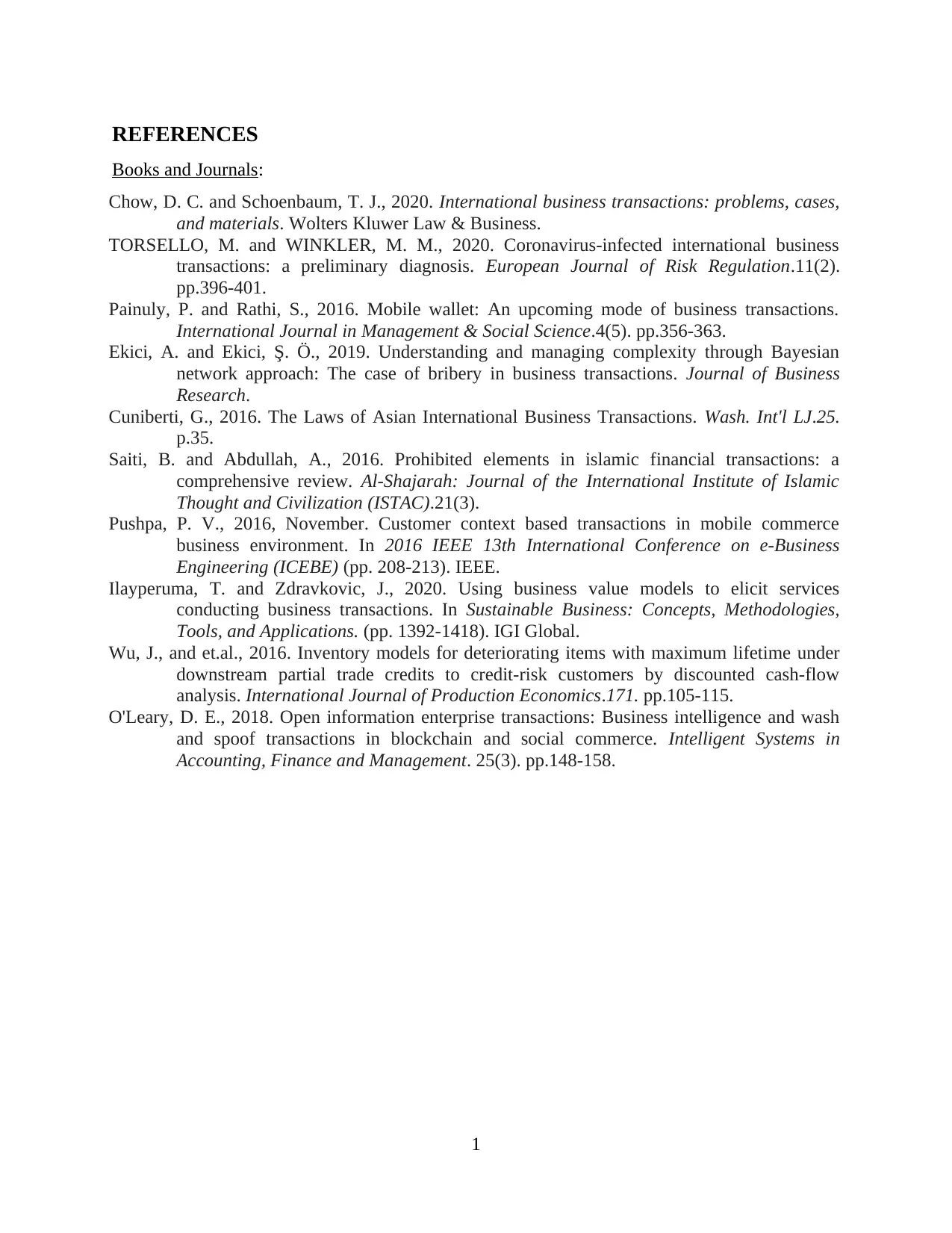
REFERENCES
Books and Journals:
Chow, D. C. and Schoenbaum, T. J., 2020. International business transactions: problems, cases,
and materials. Wolters Kluwer Law & Business.
TORSELLO, M. and WINKLER, M. M., 2020. Coronavirus-infected international business
transactions: a preliminary diagnosis. European Journal of Risk Regulation.11(2).
pp.396-401.
Painuly, P. and Rathi, S., 2016. Mobile wallet: An upcoming mode of business transactions.
International Journal in Management & Social Science.4(5). pp.356-363.
Ekici, A. and Ekici, Ş. Ö., 2019. Understanding and managing complexity through Bayesian
network approach: The case of bribery in business transactions. Journal of Business
Research.
Cuniberti, G., 2016. The Laws of Asian International Business Transactions. Wash. Int'l LJ.25.
p.35.
Saiti, B. and Abdullah, A., 2016. Prohibited elements in islamic financial transactions: a
comprehensive review. Al-Shajarah: Journal of the International Institute of Islamic
Thought and Civilization (ISTAC).21(3).
Pushpa, P. V., 2016, November. Customer context based transactions in mobile commerce
business environment. In 2016 IEEE 13th International Conference on e-Business
Engineering (ICEBE) (pp. 208-213). IEEE.
Ilayperuma, T. and Zdravkovic, J., 2020. Using business value models to elicit services
conducting business transactions. In Sustainable Business: Concepts, Methodologies,
Tools, and Applications. (pp. 1392-1418). IGI Global.
Wu, J., and et.al., 2016. Inventory models for deteriorating items with maximum lifetime under
downstream partial trade credits to credit-risk customers by discounted cash-flow
analysis. International Journal of Production Economics.171. pp.105-115.
O'Leary, D. E., 2018. Open information enterprise transactions: Business intelligence and wash
and spoof transactions in blockchain and social commerce. Intelligent Systems in
Accounting, Finance and Management. 25(3). pp.148-158.
1
Books and Journals:
Chow, D. C. and Schoenbaum, T. J., 2020. International business transactions: problems, cases,
and materials. Wolters Kluwer Law & Business.
TORSELLO, M. and WINKLER, M. M., 2020. Coronavirus-infected international business
transactions: a preliminary diagnosis. European Journal of Risk Regulation.11(2).
pp.396-401.
Painuly, P. and Rathi, S., 2016. Mobile wallet: An upcoming mode of business transactions.
International Journal in Management & Social Science.4(5). pp.356-363.
Ekici, A. and Ekici, Ş. Ö., 2019. Understanding and managing complexity through Bayesian
network approach: The case of bribery in business transactions. Journal of Business
Research.
Cuniberti, G., 2016. The Laws of Asian International Business Transactions. Wash. Int'l LJ.25.
p.35.
Saiti, B. and Abdullah, A., 2016. Prohibited elements in islamic financial transactions: a
comprehensive review. Al-Shajarah: Journal of the International Institute of Islamic
Thought and Civilization (ISTAC).21(3).
Pushpa, P. V., 2016, November. Customer context based transactions in mobile commerce
business environment. In 2016 IEEE 13th International Conference on e-Business
Engineering (ICEBE) (pp. 208-213). IEEE.
Ilayperuma, T. and Zdravkovic, J., 2020. Using business value models to elicit services
conducting business transactions. In Sustainable Business: Concepts, Methodologies,
Tools, and Applications. (pp. 1392-1418). IGI Global.
Wu, J., and et.al., 2016. Inventory models for deteriorating items with maximum lifetime under
downstream partial trade credits to credit-risk customers by discounted cash-flow
analysis. International Journal of Production Economics.171. pp.105-115.
O'Leary, D. E., 2018. Open information enterprise transactions: Business intelligence and wash
and spoof transactions in blockchain and social commerce. Intelligent Systems in
Accounting, Finance and Management. 25(3). pp.148-158.
1
1 out of 16
Related Documents
Your All-in-One AI-Powered Toolkit for Academic Success.
+13062052269
info@desklib.com
Available 24*7 on WhatsApp / Email
![[object Object]](/_next/static/media/star-bottom.7253800d.svg)
Unlock your academic potential
© 2024 | Zucol Services PVT LTD | All rights reserved.





